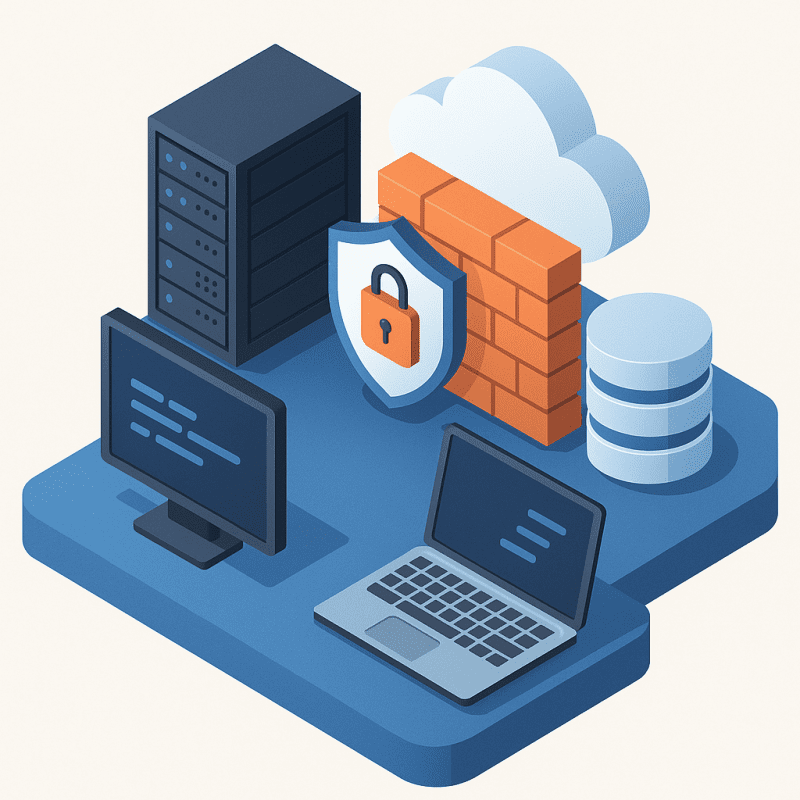Table of Contents Show
Let’s face it – IT infrastructure rarely excites anyone outside of the tech department. It’s not flashy. It doesn’t make headlines. And unlike AI tools or shiny mobile apps, it doesn’t get showcased in investor presentations. But guess what? It’s often the boring, routine, deeply technical improvements that make or break a company’s ability to scale, compete, and survive.
This article is for the decision-makers who know they need to grow – but are ignoring the very foundation on which that growth sits. We’re going to break down the “unsexy” side of IT that actually fuels real business outcomes – like faster product delivery, better customer experiences, and higher margins.
The Myth of the Shiny Object
The average executive today is bombarded by pitches about the latest AI model, blockchain application, or quantum computing breakthrough. While those things can be game-changers, obsessing over them while your core infrastructure is failing is like upgrading the stereo in a car with no brakes.
Companies often rush into digital transformation without fixing their legacy systems, or they roll out cloud tools without addressing poor network latency. The result? Expensive tech with poor ROI.
Here’s the truth: if your infrastructure is slow, fragile, or outdated, everything else slows down with it. Growth isn’t just about what you can build – it’s about whether you can build it reliably, securely, and at scale.
What Counts as “Unsexy” Infrastructure Fixes?
Let’s define what we’re talking about. These are the kinds of IT improvements that don’t make waves in the boardroom – but quietly enable massive productivity and profitability:
| Fix Type | Description | Example Benefit |
|---|---|---|
| Network Optimization | Improving latency, redundancy, and bandwidth | Speeds up transactions and communications |
| Database Refactoring | Streamlining schema, indexing, and queries | Cuts load times, improves analytics |
| Storage Consolidation | Migrating to better storage architectures (e.g. SSDs, object storage) | Reduces costs and improves access speeds |
| Server Virtualization | Better resource usage through hypervisors and containers | Increases server utilization and agility |
| Identity and Access Management (IAM) | Enforcing stronger access protocols | Reduces security incidents |
| Patch Management | Regular updating of software and OS | Prevents downtime and cyberattacks |
| Backup and Recovery Planning | Solid disaster recovery plans and redundant data centers | Improves resilience and reduces risk |
Now let’s unpack why these mundane-sounding fixes matter so much.
1. Network Optimization: The Hidden Bottleneck
A slow or unreliable network can choke your entire operation. Whether you’re dealing with cloud apps, remote teams, or IoT devices, your network is the lifeblood of your digital ecosystem.
Take latency – a 100ms delay in your e-commerce backend can slash conversions. Amazon famously found that every 100ms of latency costs them 1% in sales. That number scales with your business. So optimizing your DNS, upgrading to fiber, or reconfiguring routers may sound boring – but it directly impacts revenue.
Case in point: A global logistics firm shaved 20% off their shipping processing time simply by restructuring their VPN traffic and implementing SD-WAN (Software-Defined Wide Area Networking).
2. Database Refactoring: Because Fast Data = Fast Decisions
Most companies treat their databases like a junk drawer – everything goes in, nothing gets cleaned out. But bloated tables, poorly indexed fields, and legacy schema design can paralyze apps and analytics.
When you fix your database, dashboards load faster, customer queries resolve in milliseconds, and predictive models train faster.
Real-world stat: Dropbox migrated from MySQL to a custom in-house database and gained over 30% improvement in performance, reducing latency across millions of users.
Refactoring doesn’t mean ripping everything out. It often means reorganizing indexes, removing old tables, denormalizing where needed, and caching smartly.
3. Storage Consolidation: From Clutter to Clarity
Many businesses accumulate a Frankenstein’s monster of hard drives, NAS boxes, and cloud storage over time. The result is inefficiency, high costs, and risk of data loss.
Modern storage solutions like distributed file systems, SSD-based arrays, and object storage (like Amazon S3 or Azure Blob) offer:
- Faster read/write speeds
- Scalability
- Lower cost per GB
- Better backups
Why it matters: Imagine a design firm waiting 30 seconds to open a 4K file stored on an old RAID array. Multiply that by 50 employees doing it 20 times a day. That’s thousands of hours lost each year.
Fixing this “invisible drag” can deliver real productivity gains.
4. Server Virtualization and Containerization: Doing More With Less
If you still have racks of underused physical servers, you’re wasting money. Virtualization technologies like VMware, Hyper-V, and containerization tools like Docker allow you to run many virtual machines or applications on the same hardware – cutting costs and increasing flexibility.
Key benefits:
- Faster deployment
- Easier scaling
- Lower power and hardware costs
- Easier backups and migration
A government IT department saved over $2 million annually by consolidating 100+ physical servers into 10 hypervisors running virtualized environments. Nothing sexy about it – just smart infrastructure work.
5. Identity and Access Management: Prevent the Human Disaster
If you think growth is only held back by tech, think again. Human error – like an intern accidentally deleting production data or a former employee retaining access to sensitive systems – is one of the top causes of breaches.
Strong IAM systems – think zero trust, SSO (single sign-on), role-based access – are crucial.
According to a 2023 report from IBM, the average data breach costs $4.45 million. And the most common attack vector? Compromised credentials.
IAM is unglamorous, but when it’s not working, your growth can grind to a halt – through legal exposure, customer distrust, or just plain downtime.
6. Patch Management: The Maintenance That Saves You
Nobody likes patching systems. It’s tedious. It often causes unexpected bugs. But NOT patching? That’s how ransomware gets in.
The infamous WannaCry ransomware attack exploited an unpatched Windows vulnerability and cost businesses over $4 billion worldwide.
Fixing it involves:
- Automating patch updates
- Scheduling downtime windows
- Testing patches in sandboxes
- Tracking compliance
Like flossing, patch management is boring – but the alternative is a root canal you won’t forget.
7. Backup and Recovery: The Last Line of Defense
If your company can’t recover fast from a system failure or cyberattack, you’re not ready to grow – you’re a sitting duck.
Good backup and recovery systems:
- Use the 3-2-1 rule (3 copies, 2 types of storage, 1 offsite)
- Are tested regularly
- Allow rapid failover
Consider this stat: 93% of companies without disaster recovery who suffer a major data disaster are out of business within one year, according to the University of Texas.
Growth depends on resilience, and resilience depends on your backups.
How These Fixes Drive Real Growth
Let’s tie the boring fixes back to exciting outcomes.
| Infrastructure Fix | Growth Impact |
|---|---|
| Faster networks | Faster product rollouts, better customer UX |
| Optimized databases | Smarter decisions, faster transactions |
| Better storage | Time savings, reliability, happier teams |
| Virtualization | Lower costs, faster deployments |
| Strong IAM | Fewer breaches, better compliance |
| Patch management | Fewer disruptions, more uptime |
| Solid backups | Higher resilience, investor confidence |
Why Most Companies Delay These Fixes
Three reasons:
- They’re not visible. You can’t screenshot a good server configuration.
- They require downtime. Leadership resists even brief disruption.
- They’re hard to explain. Try pitching “packet loss optimization” at a quarterly review.
But the best leaders know this: infrastructure is like the foundation of a building. No one sees it, but without it, the whole structure collapses.
How to Prioritize Fixes (Without Getting Overwhelmed)
Here’s a simple roadmap.
- Audit first. Use tools like SolarWinds, Zabbix, or AWS Trusted Advisor to identify bottlenecks.
- Score based on impact. Fixes that unlock team productivity or reduce critical risk come first.
- Avoid the “big bang.” Prioritize small, sequential upgrades.
- Automate everything you can. Especially backups, patches, and monitoring.
- Track before/after metrics. Show latency drops, uptime increases, and cost savings in plain English.
What Happens When You Get This Right
Companies that invest in unsexy infrastructure reap real rewards.
Case Study: Etsy
Etsy overhauled its deployment systems and infrastructure in 2019, introducing automated testing and containerized workflows. The result? Faster iteration cycles, higher uptime, and a direct increase in developer productivity – which translated into more features, faster bug fixes, and improved customer retention.
Case Study: Netflix
Netflix built its own cloud infrastructure (Simian Army, Chaos Monkey) to ensure redundancy and scalability. While most companies focused on flashy UI, Netflix quietly became one of the most resilient digital platforms on Earth. It now serves over 260 million subscribers globally with near-zero downtime.
Final Word: The Unsexy Work Is the Work
Everyone wants the flashy dashboard, the AI chatbot, the slick mobile app. But what powers all of it? Servers. Networks. Storage. Access control. Recovery systems.
That’s the real growth engine.
Investing in IT infrastructure is like investing in plumbing for a skyscraper. It’s invisible. But without it, nothing flows, nothing scales, and nothing survives.
References
- Amazon latency impact stat: https://en.wikipedia.org/wiki/Website_performance
- IBM Cost of a Data Breach Report 2024: https://www.ibm.com/reports/data-breach









